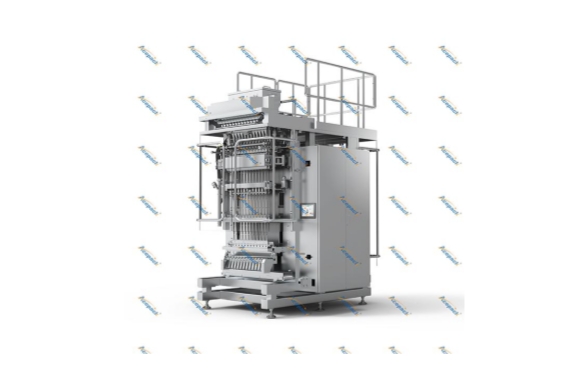In modern automated production lines, packaging machinery plays a vital role. Among them, multi-lane packaging machines and horizontal packaging machines, as two common packaging equipment, each have their unique characteristics suitable for different production needs. This article briefly compares these two types of packaging machines to assist enterprises in making informed decisions based on their requirements.

Working Principles and Structures
Multi-Lane Packaging Machine: Relies on precise mechanical transmission and control systems. Products enter the feeding port via conveyors, then are evenly distributed to various packaging lanes through sensors and controllers. Each lane pushes products into respective packaging molds made of heat-sealable material. After sealing, the packaged products are ejected and quality-checked.
Horizontal Packaging Machine: Automatically forms bags horizontally, fills, and seals them. Suitable for packaging various powders, pastes, and granular materials due to its adaptability to different materials and bag types.
Performance Characteristics
Multi-Lane Packaging Machine: Known for high efficiency, precision, and stability. Capable of handling multiple lanes simultaneously, suitable for large-scale production. Highly versatile, accommodating different product specifications and shapes. Widely used in pharmaceuticals, food, and cosmetics industries.
Horizontal Packaging Machine: Offers ease of operation, broad applicability, fast packaging speeds, and cost-effectiveness. Its simple structure facilitates cleaning and maintenance, ensuring product hygiene.
Application Scenarios and Flexibility
Multi-Lane Packaging Machine: Excels in high-speed, high-capacity packaging scenarios. Suitable for loose, non-sticky, granular materials. Offers diverse bag types and shapes, meeting market aesthetics demands. Adjustable parameters cater to various product specifications.
Horizontal Packaging Machine: Ideal for diverse packaging materials and adjustable bag types. Its horizontal bag movement allows for additional workstations, facilitating mixed material packaging. Optional feeding devices ensure precise metering.
Costs and Maintenance
Multi-Lane Packaging Machine: Higher initial investment but quickly recovered due to high productivity. Requires professional maintenance with relatively high costs.
Horizontal Packaging Machine: Lower initial investment and maintenance costs due to its simpler structure. Components are easy to replace, extending equipment lifespan and lowering usage costs.
Conclusion
In summary, multi-lane and horizontal packaging machines each have unique advantages suited to different production needs. When choosing, enterprises should consider product characteristics, production scale, cost budget, and market demand. For high-speed, high-capacity packaging with aesthetic demands, multi-lane machines are preferred. For diverse packaging materials requiring adjustable bag types, horizontal machines offer advantages. Regardless of the choice, enterprises should focus on equipment maintenance to ensure long-term stable operation and maximize value creation.



